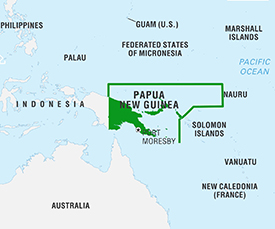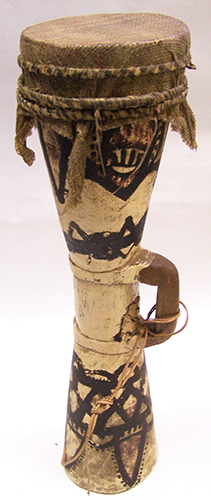Papua New Guinea: Make a Drum
About Papua New Guinea

Papua New Guinea is an island country in the southwestern Pacific Ocean. It encompasses the eastern half of New Guinea, the Bismarck Archipelago, and parts of the Admiralty and Solomon Islands chains along with other small islands and atolls.
With over 700 indigenous ethnic groups and more than 820 native languages, Papua New Guinea is one of the most culturally diverse countries in the world. Only about 18% of its population live in urban areas. Most of its 8 million people live in thousands of rural villages, which are divided by language, customs, and traditions.
Drumming in Papua New Guinea
Slit drums and hand drums are almost ubiquitous in Papua New Guinea. There are only a few regions and a small number of groups that do not use them. To the Papuan people, drums represent the voice of spirits and ancestors. They are used for religious ceremonies and secular occasions. The voice of a drum can carry long distances to announce meetings, convey message, call individuals, issue warnings, and even contact neighboring villages. They are also used in ceremonies for birth, death, the completion of a house, and the initiation of a canoe.
Slit Drums
In Papua New Guinea, a slit drum is called garamut. Created from a single log, it is hollowed by carving and burning it through a narrow slit cut along the top. Slit drums differ by region, village, and group. Some can be plain, while others may be engraved and painted.
The slit drum is considered to be a sacred instrument. Because of its sacred nature, it is usually kept in the men’s ritual house. Some groups have strict taboos against women seeing, touching, or playing the garamut.
A garamut can be played with one or two sticks by hitting the drum either near the slit or on the sides. Depending on the region and people, the garamut may be played solo, in an ensemble with other slit drums, or with flutes and other types of drums.

A slit drum from the Lam Museum collection.
To see a performance of slit drumming check out this video.
Kundu

A kundu from the Lam Museum collection
In Tok Pisin, a widely spoken Papuan creole language, kundu is the generic name used for an hourglass-shaped drum.
Kundu decoration varies from village to village, but the process of creating the drums is fairly universal throughout Papua New Guinea. Men carve and burn a log to create the hourglass shape. Some kundus have a carved handle at the narrowest part. They are painted with charcoal, tree sap, and clay. The drum membrane is made from the skin of sea snakes, monitor lizards, cassowaries, pigs, or sharks, as well as introduced species like dogs, cows, deer, or goats.
Kundus are beaten using the hand and can be various sizes. Some are small enough to be played with one finger, and others can be as tall as a man.
You can watch this video from the Tumbuna Arts & Crafts of Papua New Guinea to see how a kundu is made.
Let’s make a drum!
You will need:
• Plastic bucket or similar container of any size
• Saw (or cutting tool appropriate for your container)
• Clear packing tape
• Scissors
• Chopsticks, dowels, or wooden spoons to use as drumsticks (optional)
Demonstration from the Arts Council of Greater Baton Rouge:
Once you make your drum have fun decorating the outside!

